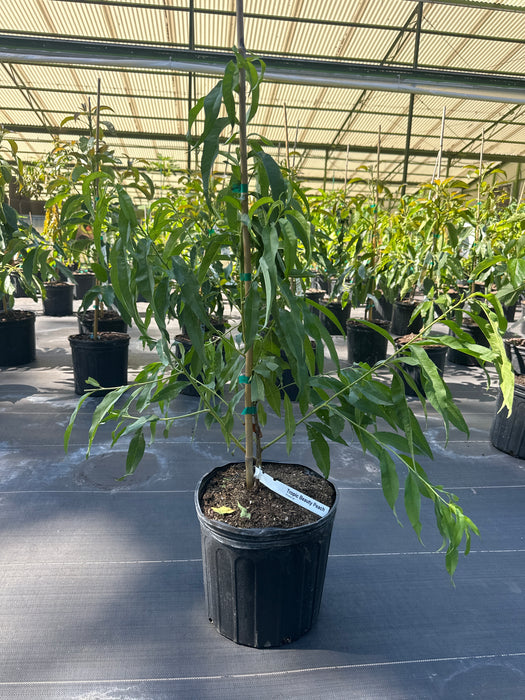
Peach-Tropic Beauty
Original price
$79.00
-
Original price
$155.00
Original price
$79.00
$79.00
-
$155.00
Current price
$79.00
Tropic Beauty Peach Tree Overview
-
Taste
-
The Tropic Beauty Peach Tree yields freestone peaches with a juicy, sweet flavor and a vibrant red blush over yellow flesh.
-
These early-ripening peaches are celebrated for their melt-in-your-mouth texture, making them perfect for fresh eating, canning, or baking in dishes like pies and cobblers.
-
The fruit offers a classic peach taste with a hint of tartness, appealing to those who enjoy a bright, summery flavor profile.
-
-
Best Growing Environment
-
Tropic Beauty thrives in warm climates with well-drained, slightly acidic to neutral soil (pH 6.0-7.0), ideally sandy loam.
-
It performs best in regions with mild winters and hot summers, such as the southeastern U.S., where it can bask in full sun and good air circulation.
-
This variety is adaptable to both in-ground and container planting, making it suitable for small yards or patios with proper care.
-
-
Botanical Name
-
The botanical name is Prunus persica 'Tropic Beauty', a cultivar developed for its low chill-hour requirement and resilience in warm climates.
-
-
Common Names
-
Known as Tropic Beauty Peach, it may also be referred to as a low-chill peach or simply Tropic Beauty in gardening communities.
-
-
Average Height
-
When unpruned, Tropic Beauty Peach Trees typically reach 12 to 15 feet tall, though they can grow up to 20 feet in ideal conditions.
-
With regular pruning, they can be kept at a manageable 8 to 10 feet, ideal for home orchards or container growth.
-
-
Growth Rate
-
This tree has a moderate growth rate, adding approximately 12 to 18 inches per year under optimal conditions.
-
It often begins bearing fruit within 2 to 3 years after planting, especially when grafted, making it a relatively fast producer for a fruit tree.
-
-
Sun Requirements
-
Full sun is essential, requiring at least 6 to 8 hours of direct sunlight daily to ensure robust growth and maximum fruit yield.
-
Planting in a shaded area can lead to reduced vigor and poor fruit production, so a south-facing location is ideal.
-
-
Cold Hardiness
-
Tropic Beauty is designed for low-chill environments, needing only 150 to 200 chill hours (hours below 45°F) to break dormancy.
-
It can tolerate brief dips to around 20°F but may suffer damage to buds or branches in prolonged freezes, making it less suited to cold northern climates.
-
-
Water Requirements
-
Young trees require regular watering—daily for the first week after planting, then weekly when the top 2 inches of soil dry out—until established (about 1 year).
-
Mature trees need about 1 inch of water weekly, with increased frequency during fruit development or in sandy soils, but overwatering should be avoided to prevent root rot.
-
-
Planting Guide
-
Plant in early spring in a sunny, well-drained spot; dig a hole twice as wide and as deep as the root ball, keeping the graft union 2 inches above soil level.
-
Backfill with a mix of native soil and organic compost, then apply a 3-inch layer of mulch (e.g., wood chips) in a 4- to 6-foot diameter around the base, keeping it 6 inches from the trunk.
-
Space standard trees 15 to 20 feet apart or dwarf varieties 5 to 8 feet apart to promote airflow and reduce disease risk.
-
-
Fertilizing Times and Recommended Fertilizer
-
Fertilize three times per year: early spring (late February to early March), late spring (May), and midsummer (July), using a balanced 10-10-10 fertilizer or a citrus-specific blend with micronutrients like zinc and iron.
-
Apply 1 pound of fertilizer per year of tree age (up to 8 pounds total), spread evenly 12 inches from the trunk; avoid fertilizing after July to prevent late growth vulnerable to frost.
-
Water thoroughly after application to help nutrients penetrate the soil, and consider soil testing to adjust for specific deficiencies.
-
-
USDA Zone
-
Tropic Beauty Peach Trees are best suited to USDA Hardiness Zones 9 to 10, though they can succeed in warmer parts of Zone 8 with proper winter protection, making them ideal for southern states like Florida, Texas, and California.
-







